Nvidia GeForce GTX 770 2 GB Graphics Card Review

Nvidia continues to roll out 7xx series graphics accelerators into the market. Today we are going to introduce to you a very worthy replacement to the good old single-GPU flagship solution – GTX 680. It is the new Nvidia GeForce GTX 770 graphics card.
The Nvidia GeForce GTX Titan graphics card has provoked a sensation not only in terms of its unprecedented performance (for a single-GPU device) but also in terms of its price. As you may know, it comes at a recommended $999. Based on the same GK110 processor, the recently released GeForce GTX 780 adds 30% to the speed of Nvidia’s single-GPU flagship of the previous generation but has a rather high price, too. It costs a recommended $649. Nvidia’s message to gamers is clear enough: pay more if you want more speed.
However, the GeForce GTX 780 release has overshadowed the announcement of what seems to be the most interesting 7 series card at the moment. Although its model names begins with a “7”, the GeForce GTX 770 is based on the 28nm GK104 processor of the Kepler series. Moreover, the latter has the same configuration as the GeForce GTX 680’s GPU but works at higher clock rates and with 17% faster GDDR5 memory. Coupled with the $50 lower recommended price ($399 vs. $499), the GeForce GTX 770 seems to be a more attractive option than the GeForce GTX 680.
So, it’s the GeForce GTX 770 graphics card that we’re going to talk about in this review.
Technical Specifications and Recommended Pricing
We are going to compare the technical specifications of the new Nvidia GeForce GTX 770 graphics card side by side with Nvidia GeForce GTX 780 and GeForce GTX 680:
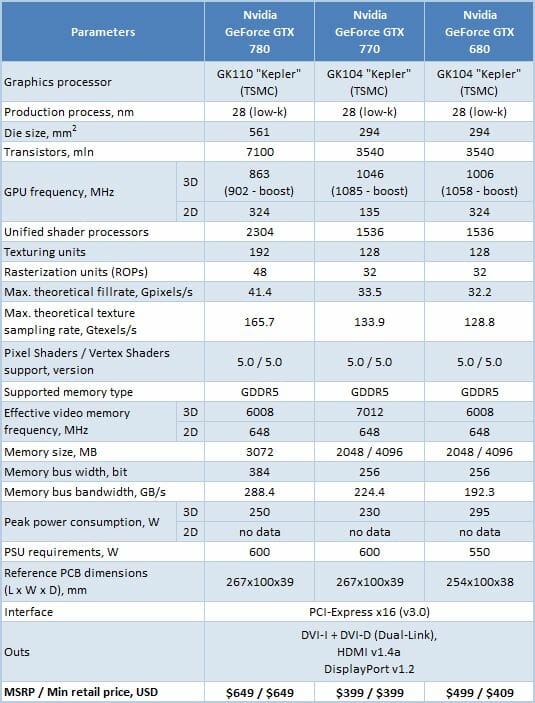
Design and Functionality
The reference cooler of the GeForce GTX Titan must have been found commercially advantageous, so Nvidia releases a third product with it already. The single difference is in the model name we can see on the cooler’s casing next to the card’s mounting bracket. It was “Titan” first, then “GTX 780”, and now it is “GTX 770″.
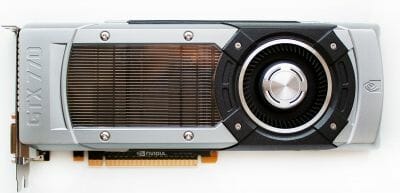
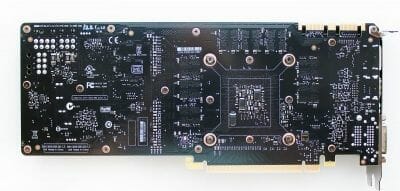
Otherwise there are no visual differences save for the lack of memory chips on the reverse side of the PCB. The product series name on the top edge of the card is highlighted, just like on the senior models.
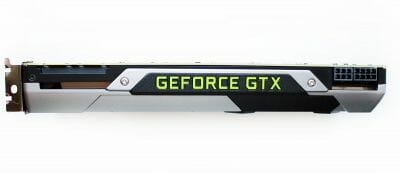
Like the GeForce GTX 780, the new card is equipped with four video outputs: dual-link DVI-I and DVI-D, HDMI 1.4a, and DisplayPort 1.2.
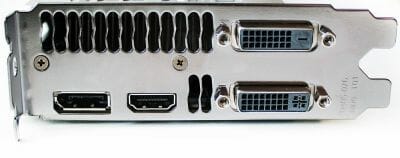
Two MIO connectors for building 2-, 3- or 4-way SLI configurations can be found in the conventional location:
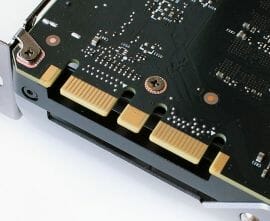
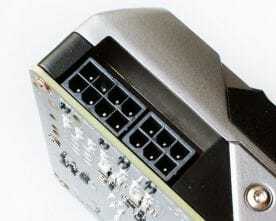
The card has one 8-pin and one 6-pin power connector and is specified to consume up to 230 watts of power. This is 35 watts more than required by the GeForce GTX 680 and 20 watts less than consumed by the GeForce GTX 780. We can see a trend towards higher power consumption as long as GPUs remain on the current manufacturing process.
The PCB resembles the GeForce GTX 780 but partially. There are fewer memory chips here. The power system layout is different.
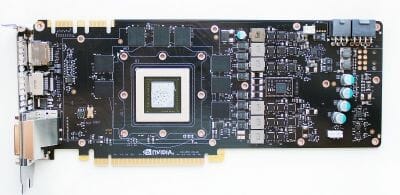
There are five power phases for the GPU, and one for memory and PLL each.
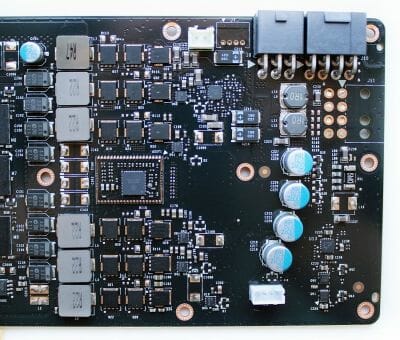
The power system is managed by an ON Semiconductor NCP 4206 controller.
The 28nm GK104 chip was manufactured in Taiwan on the 46th week of 2012 (mid-November).
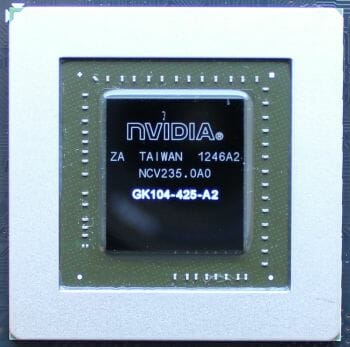
The GPU die is 294 sq. mm large, incorporating 3540 million transistors. The GPU is clocked at 1046 MHz and this frequency can be increased to 1085 MHz in boost mode. However, with the Power and Temperature Targets set at their maximums, the GPU clock rate would reach 1136 MHz during our tests, which is much higher than the specified level. In 2D applications the GPU drops its clock rate to 135 MHz while its voltage is lowered from 1.2 to 0.862 volts.
The graphics card carries 2 GB of GDDR5 memory in FCBGA-packaged chips installed on the face side of the PCB. These are Samsung Semiconductor’s K4G20325FD-FC28 components.
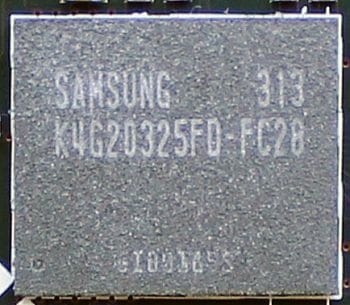
According to the manufacturer’s website, this is the fastest GDDR5 memory available from Samsung. It is rated for 7000 MHz, which is indeed the memory frequency of the GeForce GTX 770. In 2D mode the frequency is dropped to 648 MHz. The memory bus is 256 bits wide, as on the GeForce GTX 680, but the higher clock rate ensures higher bandwidth, which is increased by 32.1 GB/s or 17%.
So the Nvidia GeForce GTX 770 has the following specifications:
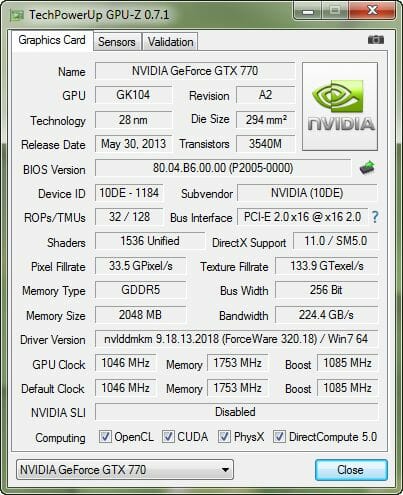
The ASIC quality of our GPU is 78.6%.
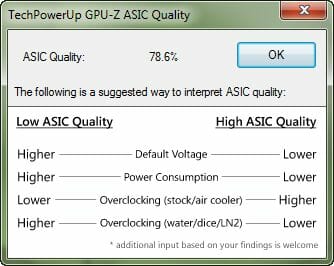
Cooling System: Efficiency and Noise
The GeForce GTX 770 has the same cooler design as the GTX 780 and Titan, except that the contact spots for power system components are somewhat different.
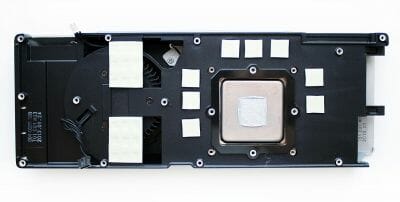
The memory chips and MOSFETs are cooled via thermal pads whereas the GPU contacts with the vapor chamber via thermal grease. The whole arrangement is cooled with a radial fan with optimized PWM-based regulation. It can rotate at a speed of 1000 to 4300 RPM.
To check out the cards temperatures we used five runs of the Aliens vs. Predator (2010) benchmark at the highest visual quality settings, at a resolution of 2560×1440 pixels, and with 16x anisotropic filtering and MSAA 4x. We used MSI Afterburner 3.0.0 beta 10 and GPU-Z version 0.7.1 for monitoring of temperatures inside the closed system case, which configuration is discussed in detail in the corresponding chapter of the roundup. All tests were performed at 25°C room temperature.
Now let’s check out the efficiency of the GeForce GTX 770 cooler in the automatic fan regulation mode:
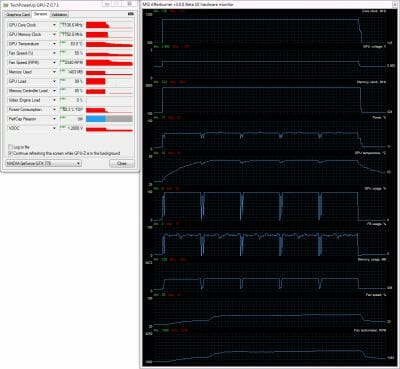
The peak GPU temperature is 83°C, the fan rotating at 2340 RPM. It must be noted that the fan accelerates very smoothly. You just don’t notice it until it reaches 2000 RPM, making itself audible against the background noise of our quiet testbed.
If the fan is manually set at its maximum speed, the GPU temperature lowers by as much as 23°C, to 60°C
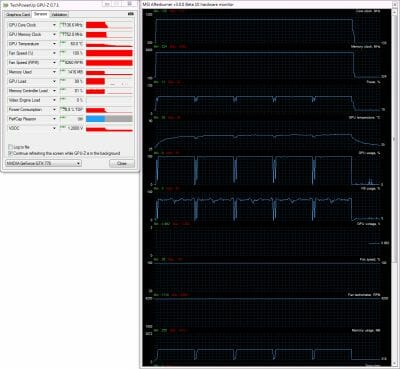
So the performance of the reference GeForce GTX 770 cooler seems to heavily depend on the speed of the fan but the developers tried to find a balance between temperature and noise while programming the fan’s behavior. We guess they succeeded. We won’t carry out noise level tests today because the card is identical to the GeForce GTX 780 in this respect, having the same cooler. We can just remind you that the cooler is quieter than the one installed on the reference AMD Radeon HD 7970 GHz Edition.
Overclocking Potential
Even though it has high clock rates by default, the GeForce GTX 770 turns out to have high overclocking potential. We managed to increase the GPU and memory frequencies of our sample by 135 and 960 MHz, respectively, without any stability or image quality issues.
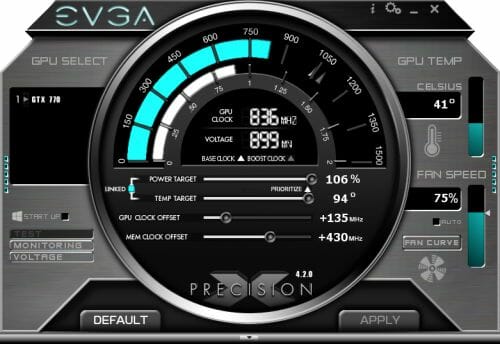
The resulting clock rates were 1181/1220/7872 MHz:
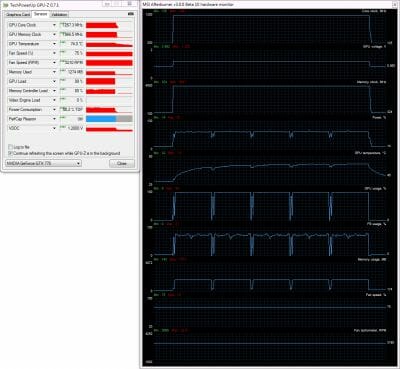
The GPU clock rate would peak up to 1267 MHz during our overclockability tests, which would have been a fantastic result any GeForce 6 series card. And here we’ve reached it with the very first sample of GeForce GTX 770!
It must be noted that we overclocked our card at 75% fan speed, which was 3210 RPM. So we didn’t have to worry about its temperature:
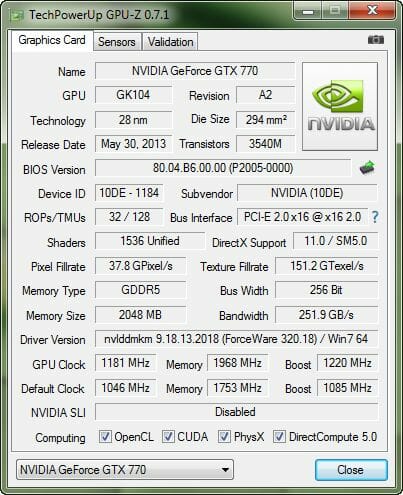
Power Consumption
We measured the power consumption of our testbed equipped with different graphics cards using a multifunctional Zalman ZM-MFC3 panel which can report how much power a computer (without the monitor) draws from a wall outlet. There were two test modes: 2D (editing documents in Microsoft Word or web surfing) and 3D. In the latter case the load was created by four runs of the introductory “Swamp” scene in Crysis 3 game at 2560×1440 with maximum image quality settings, but without MSAA.
The Nvidia GeForce GTX 770 is compared in this test with the ASUS GeForce GTX 680 DirectCU II TOP (at the standard GeForce GTX 680 frequencies), reference Nvidia GeForce GTX 780 and HIS Radeon HD 7970 IceQ X² GHz Edition:
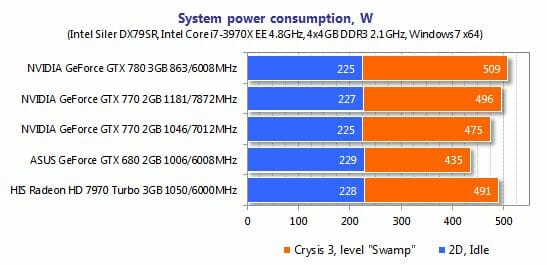
The GeForce GTX 770 configuration needs 40 watts more than the GTX 680 system at peak loads, yet remains more economical in comparison with the Radeon HD 7970 GHz Edition. The difference from the GeForce GTX 780 is 34 watts and shrinks to 13 watts when the GeForce GTX 770 is overclocked. Any of these configurations can be powered by a 550-600-watt PSU.
Testbed Configuration and Testing Methodology
All participating graphics cards were tested in a system with the following configuration:
- Mainboard: Intel Siler DX79SI (Intel X79 Express, LGA 2011, BIOS 0559 from 03/05/2013);
- CPU: Intel Core i7-3970X Extreme Edition, 3.5/4.0 GHz (Sandy Bridge-E, C2, 1.1 V, 2 x 256 KB L2, 15 MB L3);
- CPU cooler: Phanteks PH-TC14PE (2 x Corsair AF140 fans at 900 RPM);
- Thermal interface: ARCTIC MX-4;
- Graphics cards:
- NVIDIA GeForce GTX 780 3 GB 863/902/6008 MHz;
- NVIDIA GeForce GTX 770 2 GB 1046/1085/7012 MHz and 1181/1220/7872 MHz;
- ASUS GeForce GTX 680 DirectCU II TOP 2 GB (GTX680-DC2T-2GD5) 1006/1071/6008 MHz;
- HIS Radeon HD 7970 IceQ X² GHz Edition 3 GB 1050/6000 MHz;
- System memory: DDR3 4 x 4GB Mushkin Redline (Spec: 2133 MHz / 9-11-10-28 / 1.65 V);
- System drive: Crucial m4 256 GB SSD (SATA-III,CT256M4SSD2, BIOS v0009);
- Drive for programs and games: Western Digital VelociRaptor (300GB, SATA-II, 10000 RPM, 16MB cache, NCQ) inside Scythe Quiet Drive 3.5” HDD silencer and cooler;
- Backup drive: Samsung Ecogreen F4 HD204UI (SATA-II, 2 TB, 5400 RPM, 32 MB, NCQ);
- System case: Antec Twelve Hundred (front panel: three Noiseblocker NB-Multiframe S-Series MF12-S2 fans at 1020 RPM; back panel: two Noiseblocker NB-BlackSilentPRO PL-1 fans at 1020 RPM; top panel: standard 200 mm fan at 400 RPM);
- Control and monitoring panel: Zalman ZM-MFC3;
- Power supply: Corsair AX1200i 1200 W (with a default 120 mm fan);
- Monitor: 27” Samsung S27A850D (DVI-I, 2560×1440, 60 Hz).
Please meet the today’s rivals that will compete against GeForce GTX 770 in this test session:
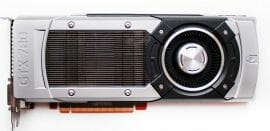
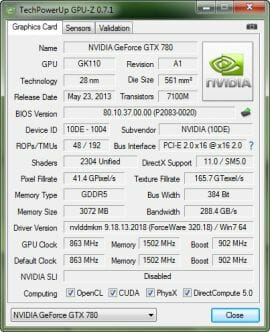
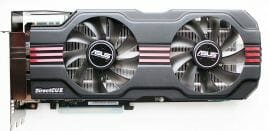
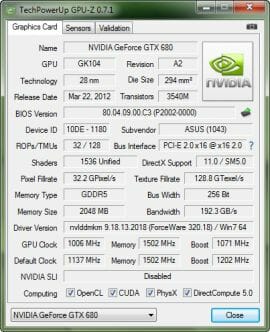
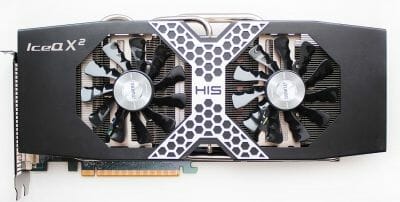
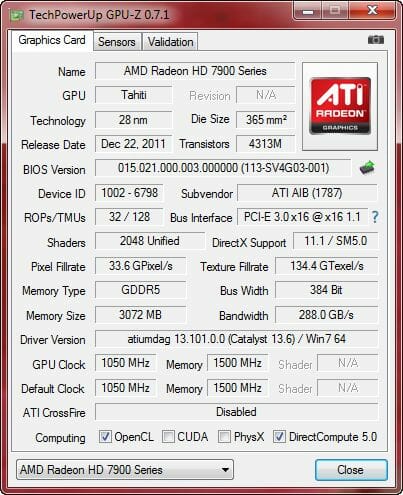
In order to lower the dependence of the graphics cards performance on the overall platform speed, I overclocked our 32 nm six-core CPU with the multiplier set at 48x, BCLK frequency set at 100 MHz and “Load-Line Calibration” enabled to 4.8 GHz. The processor Vcore was increased to 1.38 V in the mainboard BIOS:
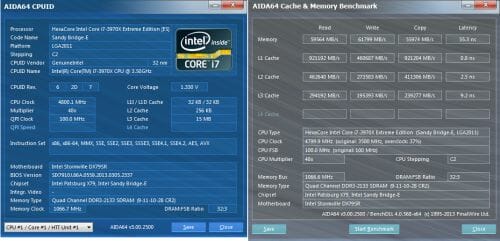
Hyper-Threading technology was enabled. 16 GB of system DDR3 memory worked at 2.133 GHz frequency with 9-11-10-28 timings and 1.65V voltage.
The test session started on June 7, 2013. All tests were performed in Microsoft Windows 7 Ultimate x64 SP1 with all critical updates as of that date and the following drivers:
- Intel Chipset Drivers 9.4.0.1017 WHQL from 03/27/2013 for the mainboard chipset;
- DirectX End-User Runtimes libraries from November 30, 2010;
- Nvidia GeForce 320.18 WHQL driver from 05/23/2013 for Nvidia based graphics cards;
- AMD Catalyst 13.6 beta 2 driver from 06/04/2013 + Catalyst Application Profiles 13.5 (CAP1) for AMD based graphics cards.
We tested the graphics cards performance in two resolutions: 1920×1080 and 2560×1440. The tests were performed in two image quality modes: “Quality+AF16x” – default texturing quality in the drivers with enabled 16x anisotropic filtering and “Quality+ AF16x+MSAA 4x(8x)” with enabled 16x anisotropic filtering and full screen 4x or 8x antialiasing, in those cases when the average fps rate remained high enough for comfortable gaming experience. We enabled anisotropic filtering and full-screen anti-aliasing from the game settings. If the corresponding options were missing, we changed these settings in the Control Panels of Catalyst and GeForce drivers. We also disabled Vsync there. There were no other changes in the driver settings.
We did change a few things in our benchmarking suite. Besdeis the traditional updates for all the existing games, we also added two new titles to the list. They are GRID 2 new auto-racing simulator and real-time strategy game called Company of Heroes 2 (in its beta version for now). As a result, our benchmarking suite now includes two popular semi-synthetic benchmarks and 12 resource-consuming games of various genres:
- 3DMark 2013 (DirectX 9/11) – version 1.0, benchmarks in “Cloud Gate”, “Fire Strike” and “Fire Strike Extreme” scenes;
- Unigine Valley Bench (DirectX 11) – version 1.0, maximum image quality settings, AF16x and(or) MSAA 4x, 1980×1080 resolution;
- Metro 2033: The Last Refuge (DirectX 10/11) – version 1.2, maximum graphics quality settings, official benchmark, “High” image quality settings; tesselation, DOF and MSAA4x disabled; AAA aliasing enabled, two consecutive runs of the “Frontline” scene;
- Total War: Shogun 2: Fall of the Samurai (DirectX 11) – version 1.1.0, built-in benchmark (Sekigahara battle) at maximum graphics quality settings and enabled MSAA 8x in one of the test modes;
- Battlefield 3 (DirectX 11) – version 1.4, all image quality settings set to “Ultra”, two successive runs of a scripted scene from the beginning of the “Going Hunting” mission 110 seconds long;
- Sniper Elite V2 Benchmark (DirectX 11) – version 1.05, we used Adrenaline Sniper Elite V2 Benchmark Tool v1.0.0.2 BETA with maximum graphics quality settings (“Ultra” profile), Advanced Shadows: HIGH, Ambient Occlusion: ON, Stereo 3D: OFF, two sequential test runs;
- Sleeping Dogs (DirectX 11) – version 1.5, we used Adrenaline Sleeping Dogs Benchmark Tool v1.0.2.1 with maximum image quality settings, Hi-Res Textures pack installed, FPS Limiter and V-Sync disabled, two consecutive runs of the built-in benchmark with quality antialiasing at Normal and Extreme levels;
- Hitman: Absolution (DirectX 11) – version 1.0.446.0, built-in test with Ultra image quality settings, with enabled tessellation, FXAA and global lighting;
- Crysis 3 (DirectX 11) – version 1.2.0.1000, all graphics quality settings at maximum, Motion Blur amount – Medium, lens flares – on, FXAA and MSAA4x modes enabled, two consecutive runs of a scripted scene from the beginning of the “Swamp” mission 110 seconds long;
- Tomb Raider (2013) (DirectX 11) – version 1.1.743.0, we used Adrenaline Benchmark Tool, all image quality settings set to “Ultra”, V-Sync disabled, FXAA and 2x SSAA antialiasing enabled, TessFX technology activated, two consecutive runs of the benchmark built into the game;
- BioShock Infinite (DirectX 11) – version 1.1.21.26939, we used Adrenaline Action Benchmark Tool v1.0.2.1, two consecutive runs of the built-in benchmark with “Ultra” and “Ultra+DOF” quality settings;
- Metro: Last Light (DirectX 11) – version 1.0.4, we used built-in benchmark for two consecutive runs of the D6 scene. All image quality and tessellation settings were at “Very High”, “Advanced PhysX technology was enabled, we tested with and without SSAA antialiasing;
- GRID 2 (DirectX 11) – version 1.0.82.5097, we used built-in benchmark, graphics image quality settings were at their maximum in all aspects, the tests were run with and without MSAA 8x antialiasing with eight cars on the Chicago track;
- Company of Heroes 2 beta (DirectX 11) – version 3.0.0.9614, two consecutive runs of the integrated benchmark at maximum image quality and physics effects settings.
If the game allowed recording the minimal fps readings, they were also added to the charts. We ran each game test or benchmark twice and took the best result for the diagrams, but only if the difference between them didn’t exceed 1%. If it did exceed 1%, we ran the tests at least one more time to achieve repeatability of results.
Performance
3DMark (2013)
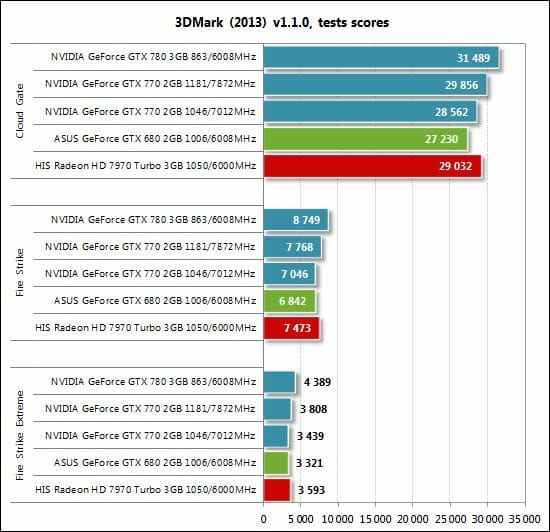
As expected, the Nvidia GeForce GTX 770 finds itself between the GeForce GTX 680 and GTX 780 in terms of performance, yet it is closer to the former than to the latter. And the GeForce GTX 780 enjoys a larger advantage in the heavier 3DMark scenes.
The Radeon HD 7970 GHz Edition performs successfully in 3DMark. Released about a year and a half ago, the AMD card (we all remember about its rebranding, of course) is just as good as Nvidia’s newcomer.
Unigine Valley Bench
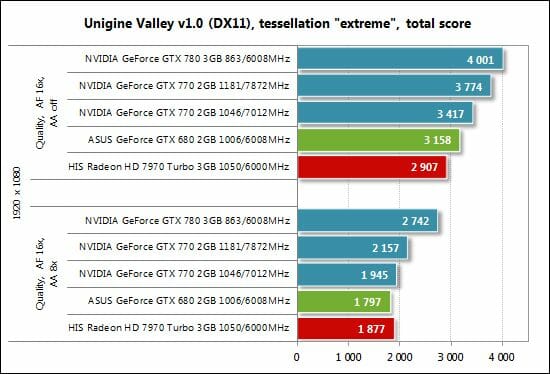
We’ve got a somewhat different picture in the Unigine Valley benchmark. The GeForce GTX 770 is again in between the GTX 680 and GTX 780. Overclocking helps it get closer to the latter card but not catch up with it, as opposed to the overclocked GeForce GTX 780 in its competition with the GTX Titan we watched in our earlier review. As for the Radeon HD 7970 GHz Edition, it is only competitive when antialiasing is turned on.
Metro 2033: The Last Refuge
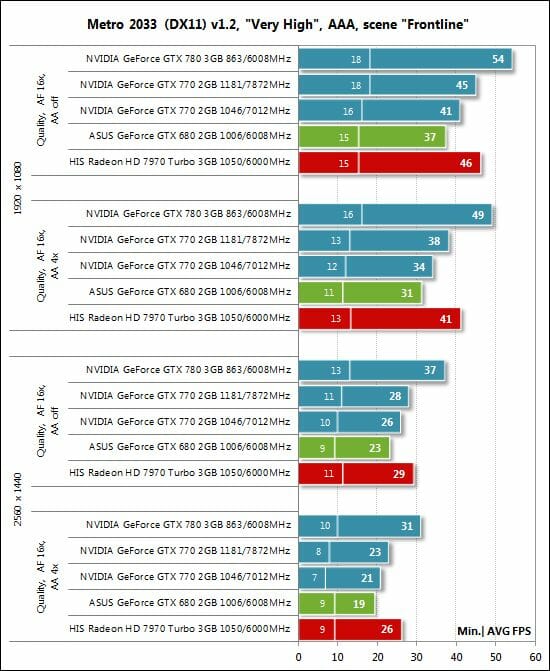
Adding 9-13% to the frame rate of the GTX 680, the GeForce GTX 770 still cannot allow Nvidia to compete with AMD in this rather old game. It’s different in the newer Metro series game as you will learn shortly, but here the GeForce GTX 770 can’t overtake the Radeon HD 7970 GHz Edition even when overclocked.
Total War: SHOGUN 2 – Fall of the Samurai
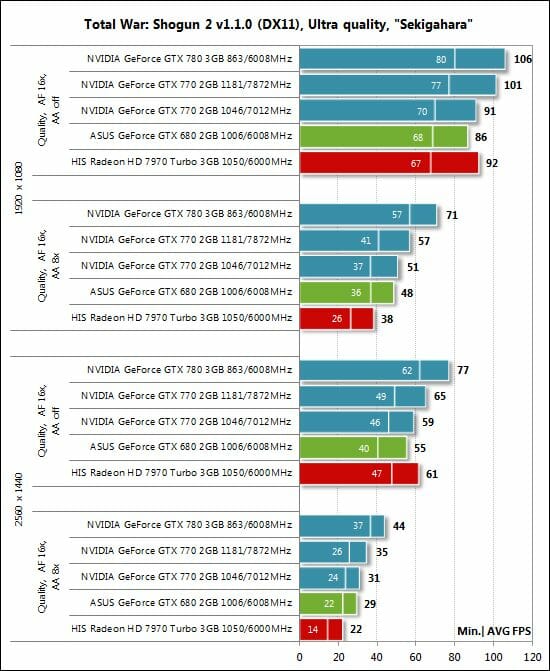
The GeForce GTX 770 doesn’t take long to revenge. It is 6-7% faster than the GeForce GTX 680 in this game. Compared to the Radeon HD 7970 GHz Edition, it delivers the same performance in the AA-less mode and wins with 8x MSAA. The GeForce GTX 780 is up to 25% ahead of its junior cousin. Our overclocking only helps to narrow this gap to 15-20%.
Battlefield 3
We see the same picture as in the previous game except that the Radeon HD 7970 GHz Edition doesn’t slow down with enabled antialiasing.
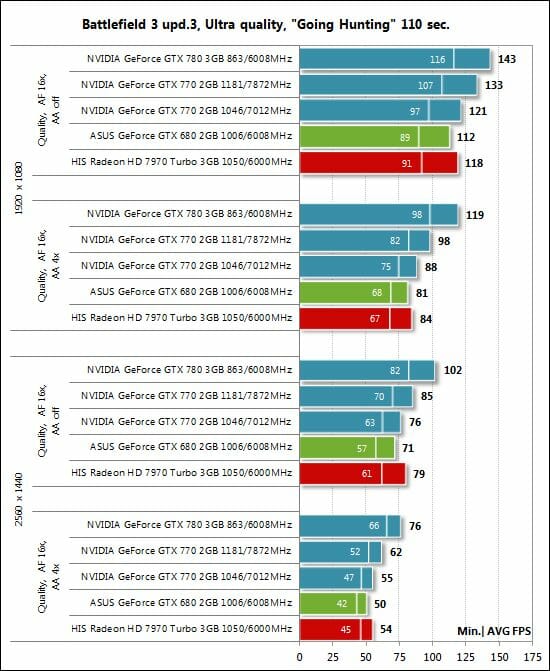
The GeForce GTX 770 is 7-10% ahead of the GeForce GTX 680, which is very good considering the lower price of the new card. Owners of the GeForce GTX 780 shouldn’t worry that they have paid too much because their card is always faster, even when the GeForce GTX 770 is overclocked.
Sniper Elite V2 Benchmark
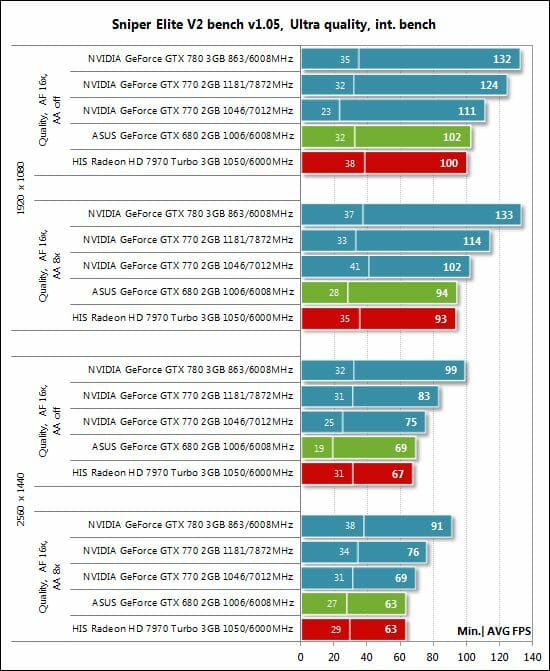
Nvidia has always been good in the Sniper Elite V2 benchmark, the GeForce GTX 770 making its standing even firmer. The new card is 9-12% faster than AMD’s Radeon HD 7970 GHz Edition. On the other hand, it is far behind the GTX 780 and cannot bridge this gap by means of overclocking.
Sleeping Dogs
AMD’s Radeon series has always been superior in this game:
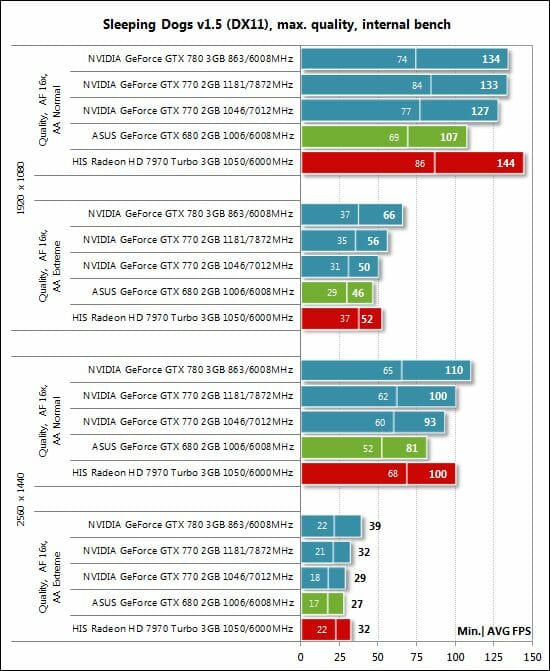
We can note that the GeForce GTX 770 is 9-19% faster than the GeForce GTX 680. The biggest gap can be observed when antialiasing is turned off. The GTX 770 can only catch up with the GTX 780 at the most CPU-dependent settings in this game.
Hitman: Absolution
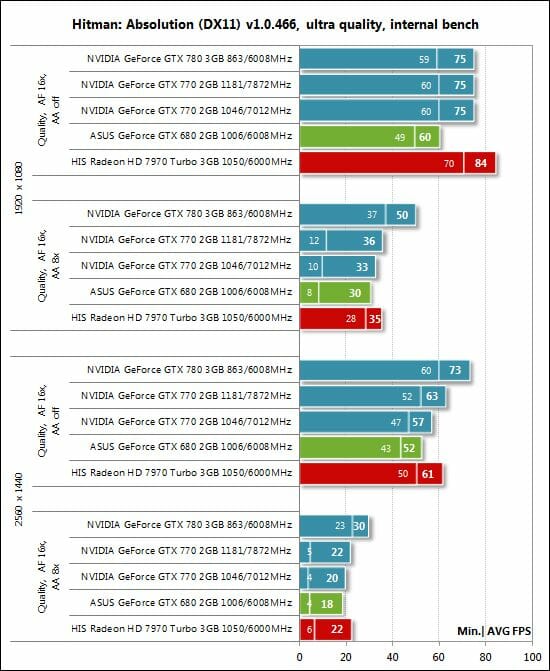
It is the third game in today’s test session where the Radeon HD 7970 GHz Edition is just as good as Nvidia’s top-end solutions. We can also note that the GeForce GTX 770 is 10-25% faster than the GeForce GTX 680 and 22-34% slower than the GTX 780.
Crysis 3
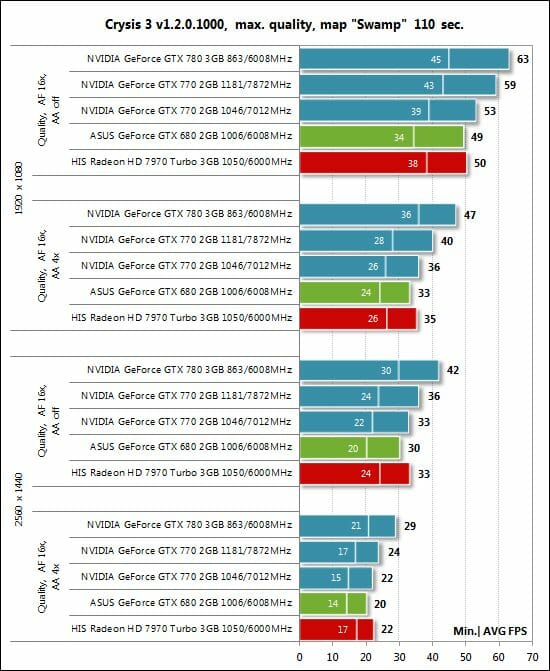
Nvidia used to lose to AMD in Crysis 3 when we compared same-category products, but it is AMD that needs to come up with an adequate answer now: the GeForce GTX 770 is as fast as the Radeon HD 7970 GHz Edition but costs less!
Tomb Raider (2013)
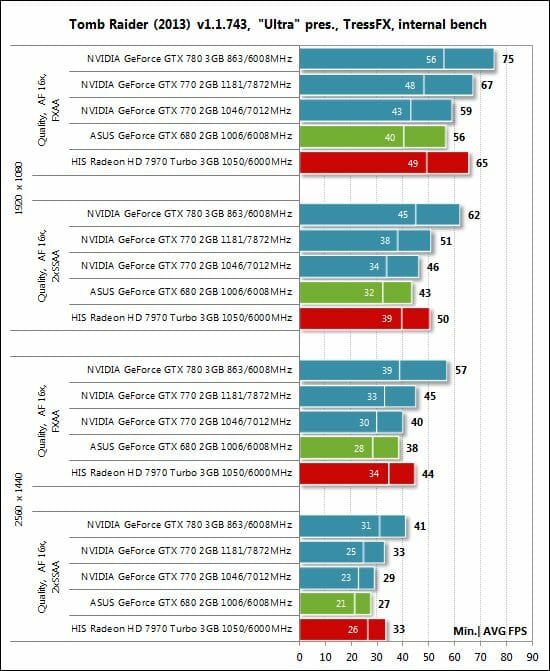
The AMD-based card is on top again. The game engine obviously favors the red team. As for the GeForce GTX 770, it is 5-7% faster than the GTX 680 and 20-30% slower than the GeForce GTX 780.
BioShock Infinite
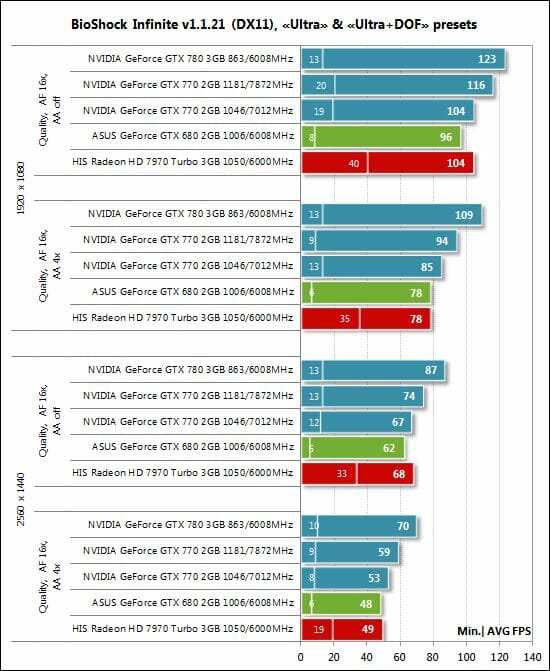
We’ve got the same standings in BioShock Infinite as in Crysis 3.
Metro: Last Light
As opposed to the first game of the series, Nvidia is superior if Advanced PhysX is turned on.
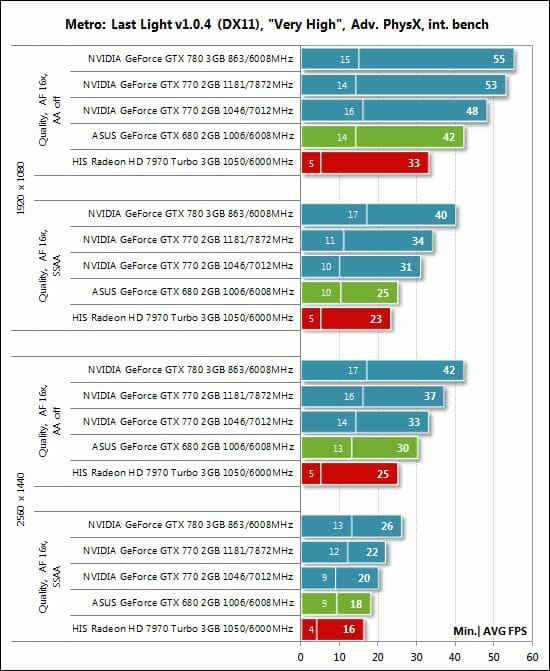
Depending on visual quality settings and resolution, the GeForce GTX 770 is 10-24% faster than the Radeon HD 7970 GHz Edition. On the other hand, the new card can’t challenge the GeForce GTX 780 even when overclocked.
AMD-based solutions look better in this game with Advanced PhysX turned off, and the Radeon HD 7970 GHz Edition is no exception:
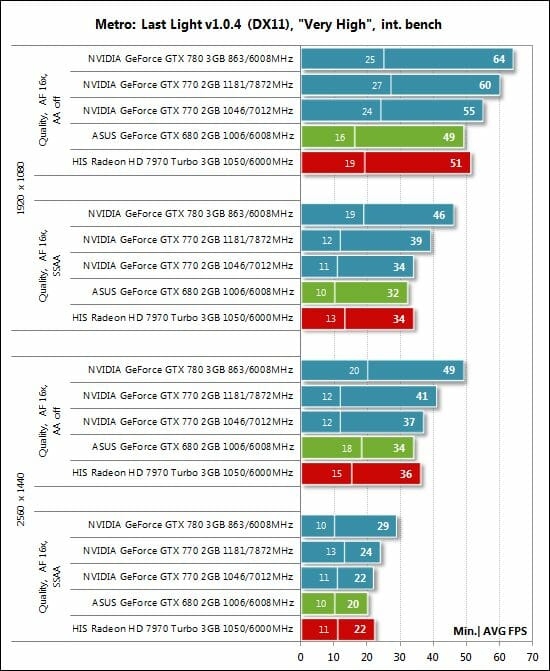
GRID 2
It’s the first time we use this new title for our tests, so we want to show you the detailed graphics quality settings we choose in it.
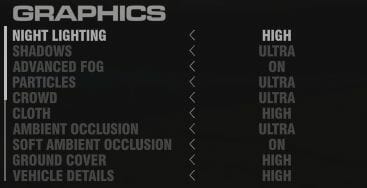
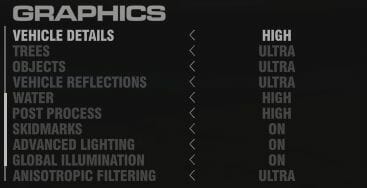
We also changed display resolution and enabled antialiasing in another game settings menu. We benchmarked our graphics cards using the Chicago test with eight cars. It is a little over 2 minutes long.
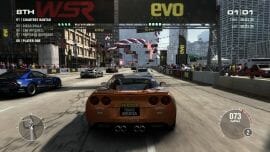
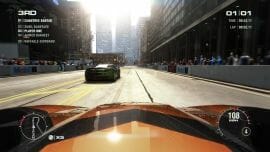
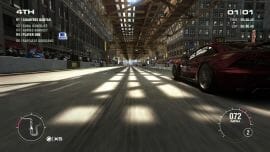
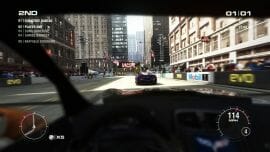
Here are the results:
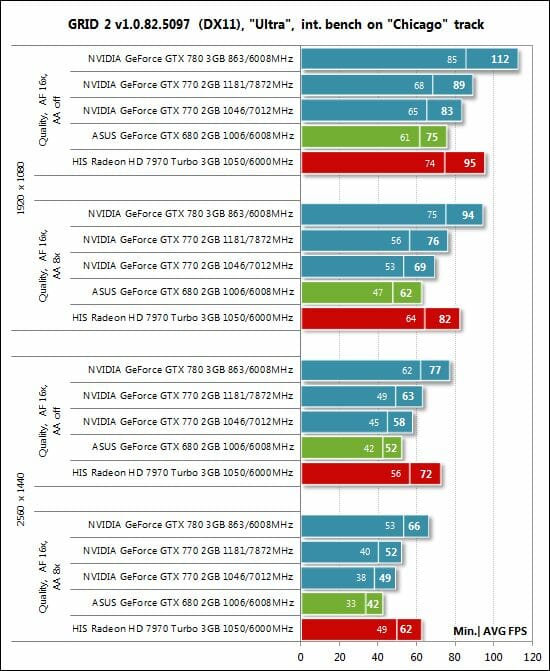
The Radeon HD 7970 GHz Edition enjoys a large advantage here, so the GeForce GTX 770 and GTX 680 can only compete with each other. The GeForce GTX 780 comes from a higher price category, so it is the only product to uphold Nvidia’s banner in this test.
Company of Heroes 2
The game was still in the process of closed beta-testing when we were writing this review, so there were some bugs in it. Antialiasing wouldn’t be enabled when we selected the related setting. And the test would freeze after changing display resolution if we didn’t exit and reload the game. That’s why today’s results shouldn’t be taken seriously. The final version of the game and subsequent patches will affect the standings of the graphics cards.
Here are the graphics quality settings we use in this game:
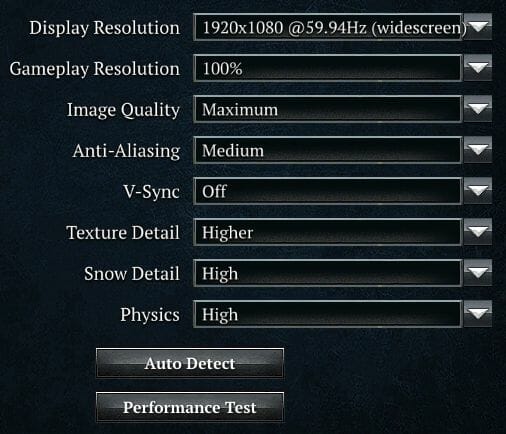
And some screenshots:
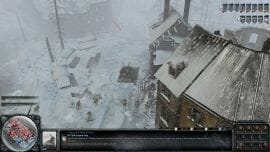
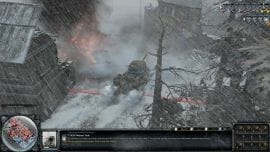
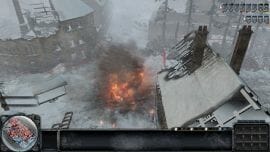
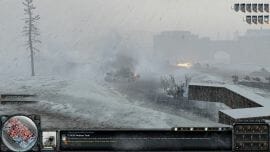
Here are the results:
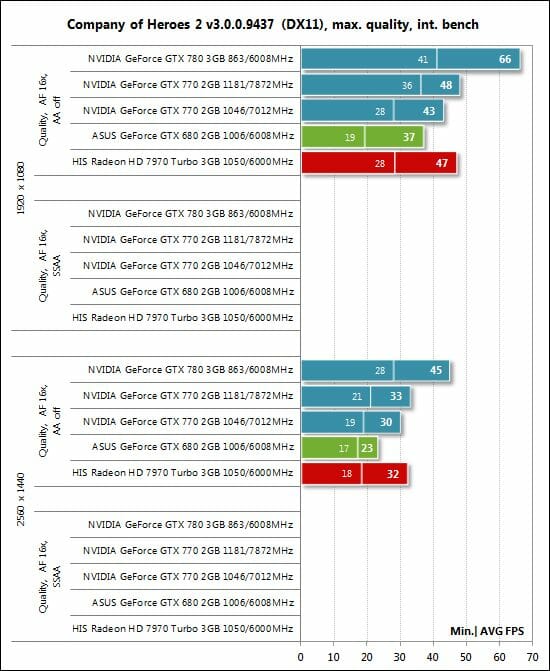
AMD is on top although the GeForce GTX 770 is very close to the Radeon HD 7970 GHz Edition. The new card is 16 to 30% ahead of the GeForce GTX 680 and more than 30% behind the GeForce GTX 780. But again, this test is too imperfect yet to be an accurate benchmark.
Here is a table with full test results, so now we can take a look at our summary charts:
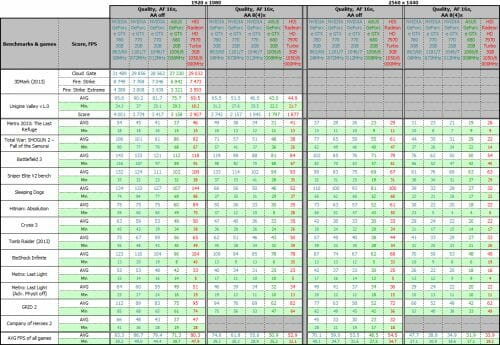
Performance Summary
First of all, let’s see what benefits the GeForce GTX 770 provides in comparison with the GeForce GTX 680, both working at their default clock rates.
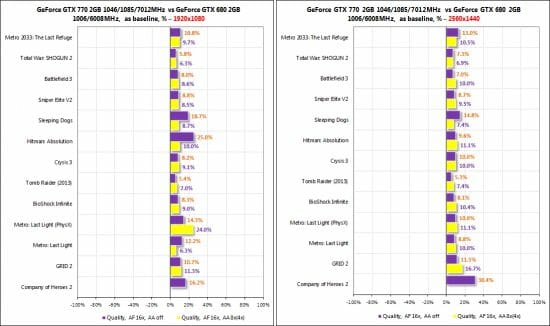
The new card is an average 9-11% faster than its predecessor. Considering the more attractive price, the GeForce GTX 770 is undoubtedly a success.
On the other hand, we have to disappoint prospective GeForce GTX 770 users a little. Their graphics card is going to be 14 to 27% slower than the GeForce GTX 780. The gap is especially large if you enable antialiasing.
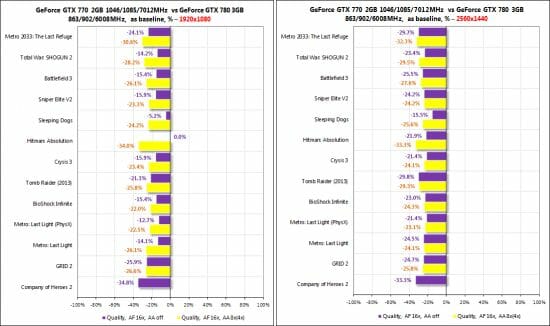
You can’t expect to bridge the gap by means of overclocking because the GeForce GTX 770 still loses to the standard GeForce GTX 780 even if clocked at 1180/1220/7872 MHz.
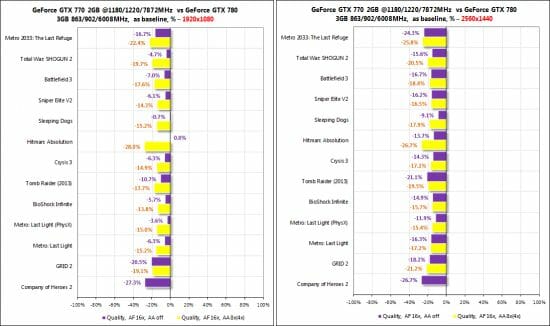
The gap is now 6 to 19%, depending on the resolution and quality settings. The GeForce GTX 780 enjoys the largest advantage when antialiasing is turned on.
Now here is the competition between the GeForce GTX 770 and the Radeon HD 7970 GHz Edition at their default clock rates:
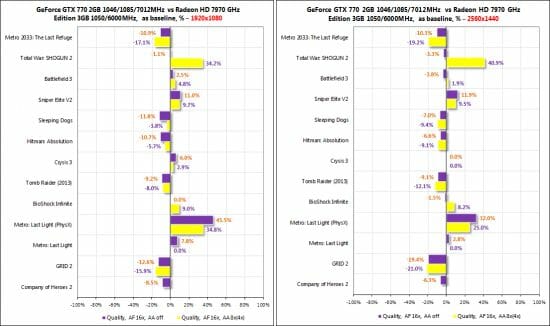
Although the GeForce GTX 770 is faster than the GeForce GTX 680, the AMD-based card is still superior in such games as Metro 2033: The Last Refuge, Sleeping Dogs, Hitman: Absolution, Tomb Raider (2013), GRID 2 and in the beta version of Company of Heroes 2. The GeForce GTX 770, in its turn, wins in Total War: SHOGUN 2 – Fall of the Samurai, Sniper Elite V2, Crysis 3 (at 1920?1080), BioShock Infinite (with antialiasing) and Metro: Last Light. Overall, the GeForce GTX 770 is an average 3% faster than the Radeon HD 7970 GHz Edition across all the tests.
CUDA and OpenCL Performance
First we checked out our graphics cards in SVPMark 3.0.3a from SmoothVideo Project (the real-life test):
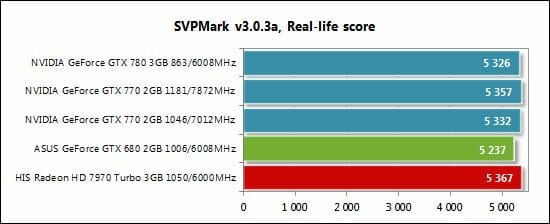
We have almost the same score irrespective of the graphics card. This test just can’t use up all of the computing potential of these products.
Next we benchmarked the speed of HD video encoding in Xilisoft Video Converter version 7.7.2, which supports both AMD and Nvidia GPUs. During the test we converted a Full-HD 2.5GB video file into an iPad 4 format. The resulting file was 750 MB large. A smaller result is better here:
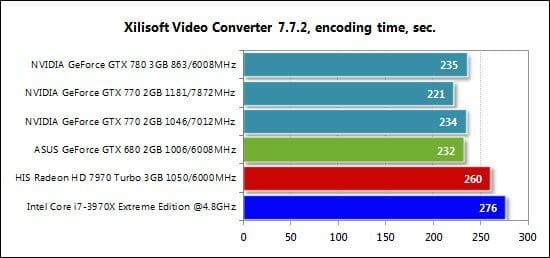
Interestingly, the standard GeForce GTX 770 turns out to be a little faster than the GeForce GTX 780, which must be due to the higher GPU clock rate because the GeForce GTX 680 performs well here, too. The Radeon HD 7970 GHz Edition encodes video at a slower rate than the Nvidia-based cards, yet is anyway faster than the overclocked six-core Intel CPU.
The next test is DirectCompute Benchmark version 0.45b. The diagram shows the DirectCompute and OpenCL scores:
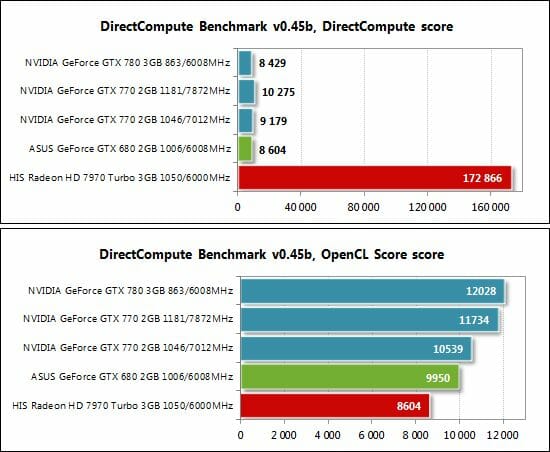
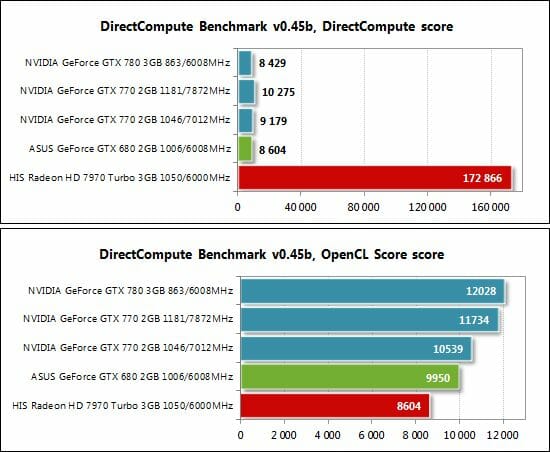
AMD is unrivalled in DirectCompute calculations but the Nvidia-based cards are ahead of the Radeon HD 7970 GHz Edition in OpenCL.
The popular LuxMark benchmark produced rather interesting results:
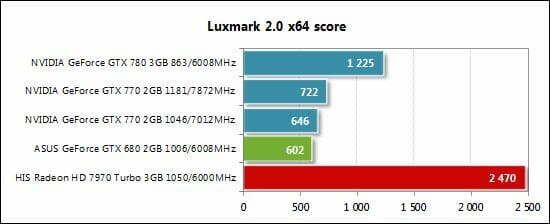
The GeForce GTX 780’s GK110 chip has almost twice the computing capabilities of the GeForce GTX 770’s GK104 processor. The Radeon’s Tahiti XT is far ahead of the opponents in LuxMark, though.
Here is a table with full test results:
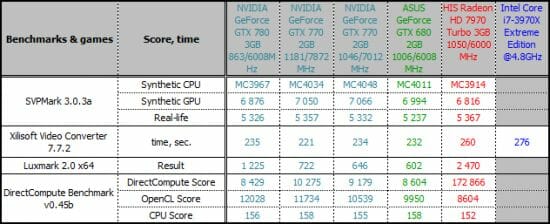
Conclusion
The new GeForce GTX 770 card from Nvidia is attractive with its price in the first place. Being 9-11% faster than the ex-flagship GeForce GTX 680, it comes at a $50 lower recommended price. Most importantly, the actual prices are exactly like that. As a result, we can see not only GeForce GTX 680 but also Radeon HD 7970 GHz Edition products getting cheaper: their prices now start from $409 and from $419, respectively.
Another important factor for the future success of the GeForce GTX 770 is its excellent overclocking potential. This is indicated by the fact that all Nvidia partners have already announced pre-overclocked versions of the card. And the factory overclocking is quite substantial, amounting to 100 MHz and more. Coupled with the good frequency potential of the graphics memory chips, the GeForce GTX 770 is perfect for overclockers. We’ll review a couple of such accelerated GeForce GTX 770s shortly.
Then, if we compare the reference GeForce GTX 770 and the reference Radeon HD 7970 GHz Edition, the former is better in terms of power consumption and noisiness. AMD’s solution should still be given credit for being unrivalled in a number of games, including some latest titles, and in DirectCompute applications, but we guess the GeForce GTX 770 is indeed the most attractive $400 graphics card available today. And if you’ve got a large monitor, you may want to try the 4GB version of it. We hope we will be able to check out the difference between 2GB and 4GB versions of the GeForce GTX 770 in the near future.